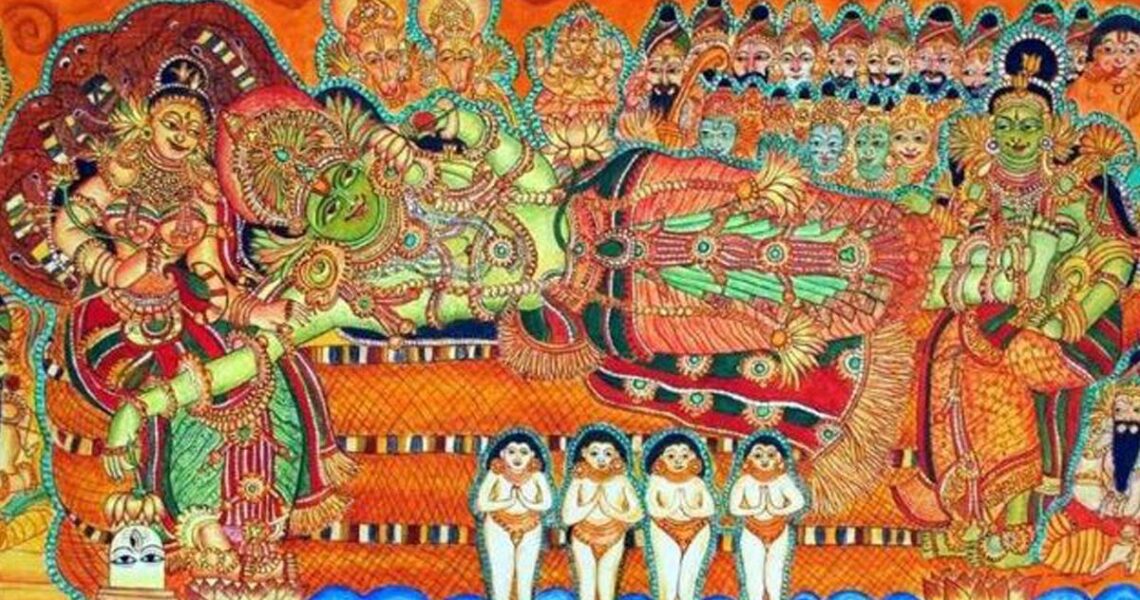33 Devas
The magnificent and beautiful essence of our Almighty could not be captured through easy words. The Vedic seers of this vast land, India kept this in mind and kept on finding such words and verses through which they could do justice with the beauty of the Supreme Reality. They tried creating hymns, which shared their perspectives. They also tried to express their visions about the Guardians of the natural and supernatural elements. These guardians were present in Three Lokas, are were referred to as Devas. In Sankrits, ‘Div’ means the ‘Shining One’.
Words like ‘Deus’ or ‘Dios’ also came from the Sanskrit root. These words are still used to refer to the Almighty in modern European languages. The new testament of Bible also contains words like Deus or Dios to refer to their God.
People around the world think that in Hindu culture there are 33 crore Devtas, which is absolutely not true, and is clearly a myth. In Sanskrit, the words ‘Koti’ has two different meaning, one of which means Crore and the other means Types. People mistakenly spread the myth as they understood 33 Koti Devtas as 33 crores Devtas. It is clearly mentioned in the oldest Hindu texts that there are 22 principle Devas, they were the guardians of Nature and Cosmic Creation.
We can find a conversation in the Brihadaranyaka Upanishad, between Rishi Vidagdha and Rishi Yagnavalkya. In this conversation, when Rishi Vidagdha asks Rishi Yagnavalkya about the actual number of Devas present in this Bhuvan (Earth). In reply to this question, Rishi Yagnavalkya clearly states that there are three thousand and three Devas who are actually the manifestations of thirty-three Devas. The thirty three Devas are:
- 12 Adityas who are generally Solar gods including Indra, Surya, Mitra and Varun
- 11 Rudras, they are the Manifestations of Lord Shiva
- 8 Vasus also known as Elemental gods such as Vayu, Agni, Antariksh and Dyaus, the Sky God
- Prajapati Brahma
- Shri Hari Vishnu
The 33 Gods
The Vedas are full of hymns dedicated to the Adityas. Sons of Aditi are collectively known as Adityas. The Vedas had various hymns dedicated to Indira, Agni, Surya, Varun and many more.
It is said that the 12 Adityas are referred to be as the 12 Solar months. These 12 Adityas also represent different attributes of social life. These are:
Ansh (represents share),
Aryaman (represents nobility),
Bhaag (represents inheritance),
Dhatri ( represents ritual skill),
Tvashtar (represents skill in crafting),
Mitra (represents friendship),
Pushan/Ravi (represents prosperity),
Savitra/Parjanya (represents rejuvenation),
Surya/Vivasvan (represents social law),
Varun (represents fate),
Vaman (represents cosmic law).
Indra/Shakra, is known to be the eldest and the undoubted leader of other Adityas. Also, he is considered to be one of the strongest Devas of all, and has proved his worth and power on numerous occasions. He is popularly known because of his exploitation of the dragon Vritra.
These 12 Adityas were also adopted by the Chinese as well as Japanese Buddhism. They further considered Them (12 Adityas) to be the guardians of the monasteries who protect all the four main directions, four semi-directions, the Sun and the Moon, above and below.
In Yazili Kaya in Turkey, a similar depiction was found in the form of rock-cut cave painting. This cave had various depictions of Hindu Gods and Goddesses which somehow looked similar to Hindu Gods.
The 8 Vasus are the known as the attendant deities of Indra. Furthermore, they are also known to be the eight elemental gods representing various sides of Nature.
Anal (represents Fire),
Anil (represents Wind),
Apas (represents Water),
Pratyusha (represents Dawn),
Dhara (represents Earth),
Dhruv (represents Pole Star),
Dyaus/Prabhas (represents Sky),
Soma (represents Moon).
The 11 Rudras are none other than various forms of the Original Rudra which also includes Lord Shiva. Shiva, Prajapati Brahma and Shri Hari Vishnu all together form a hierarchy among all the Gods, which is also known as Trimuti. The specific roles of The Trimurti are:
- Brahma, is considered to be the First in this Trinity who is the Creator and Master of all Divine Ceremonies.
- Shiva, is the Cosmic Dancer, Nataraj . He through his celestial dance, preserves the endless rhythm and tune of this Universe.
- Vishnu, is considered to be the Preserver god who every time incarnates to help mankind to fight with the Evil forces in the Universe.
As time passed, we see the emergence of other forms of the Supreme Lord and they were also included in the group of devas. Ganesh, the elephant headed son of Lord Shiv and Shakti, and Hanuman, the monkey-God who is the 12th manifestation of Lord Shiva is the principal amongst them. Others were the twin sons of Surya-Ashwini Kumars and the ten incarnations of Lord Vishnu known as Dashavatar.
Buddhist cosmology further expanded the concept of the 33 Devas and highlighted a separate Heaven for them called the Tavatimsa on top of Mount Meru, similar to Mount meru, similar to Mount Olympus of the Greeks, Indra’s father is Dayus, who in Greek mythology, is worshipped as Zeus, Deus-Pater or Ju-Piter in Roman mythology and Ju-daea in Hebrew traditions. The same name appears as Div in Slavic mythology and Ziuar Tyr in Norse Mythology.
A thorough study of the Hindu mythology provides us an insight into the thoughts and principles uphold by our ancient forefathers when they had a common belief system
The Hindus are however convinced that despite several manifestations of the Supreme Lord, God is one and only, the Supreme Being.
